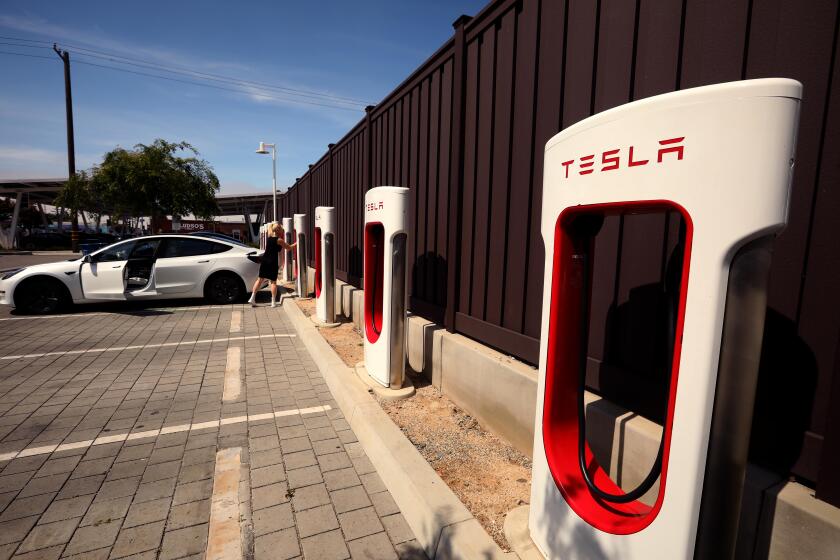A mere tinge of green
GENERAL MOTORS -- the bad-daddy patriarch of Detroit, the strangler of electric cars, the 800-pound plaintiff against air-quality rules from Washington, D.C., to Sacramento -- reached out and hugged a tree last week.
On the floor of Cobo Hall, site of the North American International Auto Show (ending Sunday), GM unveiled its Chevy Volt concept car, a wind-cheating, four-seat electric vehicle that was the sensation of the show. The Volt utters all the sacred shibboleths that EV enthusiasts have longed to hear: The Volt is a plug-in hybrid, which when charged from a wall socket should be able to travel 40 miles in all-electric mode -- more than enough to cover most people’s daily driving using nary a drop of gas.
Should the vehicle need to go farther, a super-efficient one-liter turbocharged three-cylinder engine onboard will act like a range-extending generator. The numbers suggest the Volt could be capable of up to 150 miles per gallon on trips of 60 miles or less, and 50 mpg on long-distance drives.
If GM can get the Volt’s lithium-ion batteries to work properly, says David Cole of the University of Michigan’s Center for Automotive Research, “it could be the biggest game-changer in 25 years. It’s the real thing.”
Arriving a month after GM became the first major manufacturer to commit to building a plug-in gas-electric hybrid (the Saturn Vue dual-mode hybrid), the Volt seems to confirm a volte-face for the company on matters environmental.
And GM’s not alone. Lots of companies were polishing their green cufflinks in Detroit.
Ford showed off its gull-wing Airstream concept van, a plug-in fuel cell vehicle (using hydrogen instead of an internal-combustion engine to recharge the batteries in-flight). German manufacturers touted their super-clean “Bluetec” diesel powertrains (diesels typically get about 30% better fuel economy than comparable gas-powered vehicles) and direct injection systems. Toyota showed off its aerospace-inspired hybrid-electric sports car, the FT-HS.
In sum, it was the greenest Detroit show on record. So why was I so depressed? Because all the alt-fuel, green-car progress is being made at the margins, while the vast bulk of the U.S. market -- represented in the acres of floor-groaning vehicles in Cobo Hall -- motors on as if there were no crisis.
Consider the trends: U.S. fleet average fuel economy has been stuck at around 20 mpg for several years, as technical improvements in fuel efficiency are offset by steady increases in vehicle size and horsepower. Cars are, on average, about 800 pounds heavier than they were two decades ago. Virtually every car on the market gets bigger over time. That goes double for trucks. The revised, dimension-based corporate average fuel economy calculations for light trucks, going into effect in 2011, will actually create incentives for manufacturers to build bigger trucks that will jump into bigger size brackets, with lower CAFE expectations. To stand beside Toyota’s new Tundra CrewMax half-ton pickup and consider a rule-skirting, super-sized version, a la Ford’s Super Duty, is to wilt in fear and frustration.
It is true that sales of trucks and full-size SUVs were way down in 2006, but that development didn’t translate to significant improvements in fuel consumption, which remains at near historic levels.
Hybrids? Even with considerable tax incentives available for the purchase of the vehicles, and allowing that not all hybrids are hair-shirt, high-mileage runabouts (the Lexus GS450h, for instance), hybrids tallied about 250,000 vehicles sales last year, in a 16-million-unit market. Not nothing, but hardly enough to make a dent in our 783-million-gallon-per-day gasoline habit.
What efficiency technologies there have been -- things like direct-injection, continuously variable transmissions and optimized aerodynamics -- have been outpaced by the escalating horsepower wars. Sedans and coupes with 400- and 500-hp engines are commonplace. The new Dodge Viper unveiled at the show sets an American production-car record of 600 hp. Can the Chevrolet Corvette leave that number unchallenged?
Even companies usually associated with thrift are putting their noses in the trough. The new Toyota Tundra full-size pickup offers an optional 381-hp V8 engine. Acura’s U.S. boss Dick Colliver told Automotive News this week that the company’s flagship RL sedan -- a fast and fluid performer by anyone’s reckoning -- is underpowered with a V6 and will need a V8 engine to compete.
What’s happening, says Cole, is that automakers feel compelled to cover their bets, expanding into larger and more expensive vehicle segments, e.g., the Audi Q7 SUV. “There’s a feeling that to run a business you have to stay in business,” says Cole. “Larger, more opulent vehicles are more profitable.”
The fundamental dynamic is that the manufacturers cannot count on fuel prices, so “they have to put a portfolio into the market that will be successful no matter what the price of gasoline,” says Cole.
As the Detroit show glamorously illustrates, deep dysfunction and disconnects remain on the matter of fuel efficiency and consumption. Manufacturers are joyfully exploiting a loophole in CAFE regulations that gives them extra credit for building flex-fuel vehicles, even though the fuel itself -- E85 -- is all but unavailable. At the same time carmakers crow about their new environmental consciousness, their D.C. lobbyists and lawyers are battling with states over the power to regulate greenhouse gases.
I’d be more willing to celebrate all the achievements of the auto industry if these achievements would, at last, move the needle in the right direction.
*



